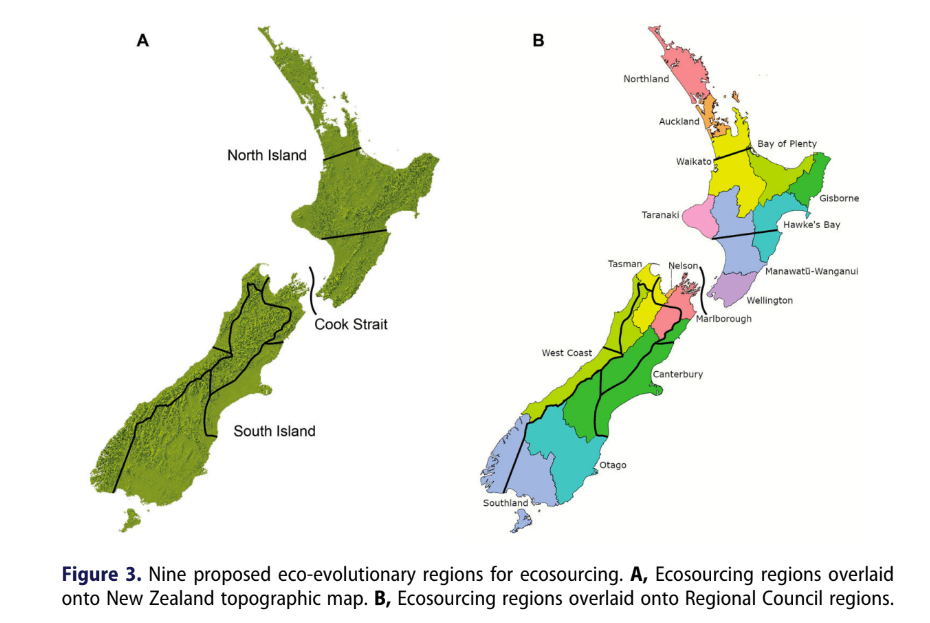Ecosourcing
Our ecosourcing approach is largely informed by the research of Heenan et al. The most recent paper by this research group is cited in full at the bottom of this page and is available here.
While ecosourcing is a term that is frequently used in the context of local councils’ requirements for Resource Consents, it has lacked a proper definition, and guidelines from DOC and district councils only suggest seed should be sourced from the same area it is being planted. In the past, we’ve used a definition borrowed from the Royal Horticultural Society in the UK that applies a distance and altitude limit to seed provenance: ecosourced plants must be propagated from seed collected within 150km and 300m in elevation from the planting site.
However, these “local” ecosourcing approaches are not scientifically informed. Furthermore, based on Heenan et al’s research they are contrary to the goals of ecosourcing, which are to preserve and improve genetic diversity and population health of native plants, to reduce inbreeding and to preserve threatened species. These goals align well with ours here at Springburn Nursery and we also believe that ecosourced plants can in many cases deliver superior plant health and survivability especially in challenging locations.
Heenan et al’s paper suggests a more relaxed approach to ecosourcing that is based on nine broad ecosourcing regions set by phylogeographic patterns and biogeographic boundaries, as below:

This is particularly important in Central Otago, where the extreme deforestation and continually obstructed regeneration of the pre-human settlement plant populations has led to remnant pockets often being small in number of individuals and low in genetic diversity. Applying a local ecosourcing approach in these situations will inevitably create genetic bottlenecks, as even common and iconic species like mountain flax and lancewoods that would once have been prolific now exist in many areas as a few scattered individuals or small populations - and robust and ideally naturally regenerating populations are necessary for proper seed sourcing. Furthermore, combine the thorough ecological destruction of the past with the dominance of novel ecosystems in the present and the result is that large portions of the original ecosystems species are missing, and restoration of these species essentially requires sourcing from outside Central Otago.
The paper used Kunzea ericoides as a case study, and following a genetic analysis combined with examining the phenotypic differentiation (the differences in observable traits between populations) and ecotypic differentiation (the gradual differences across a large, continuous population) concludes that “where widespread species exhibit phenotypic and/or ecotypic variability, it is more important to ensure the site of the ecosourced plant material is similar to the restoration site rather than focusing on the geographically closest sites.” To put it simply, in order to grow hardy kanuka for an inland mountain site, you’d want to take kanuka seed from another inland mountain site within the same broad zone, and not from a closer population of kanuka in a mild valley. This “niche matching” approach does not necessarily apply to all species but it is intuitive and has supporting evidence.
Here at Springburn Nursery we intend to use the Heenan proposed regional model for ecosourcing moving forward, and will update this approach if any further research advances it. Our ecosourcing zone therefore includes all of Otago, Southland east of the Southern Alps, and some of the Waitaki and Mackenzie districts of Canterbury. Within this zone we will endeavour to take seed when possible from large healthy populations in similar geographic and climactic conditions to Central Otago to ensure we offer the best possible plants in quality and genetic lineage.
Peter B. Heenan, William G. Lee, Matt S. McGlone, James K. McCarthy, Caroline M. Mitchell, Matthew J. Larcombe & Gary J. Houliston (2023) Ecosourcing for resilience in a changing environment, New Zealand Journal of Botany, DOI: 10.1080/0028825X.2023.2210289